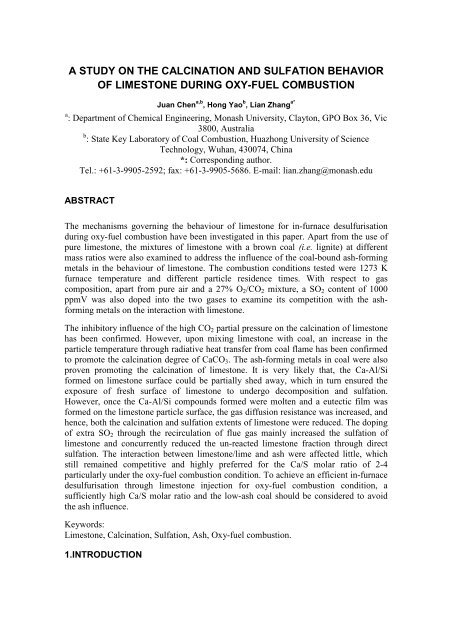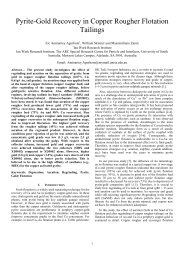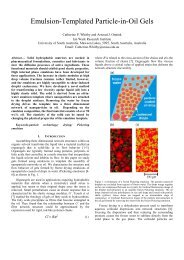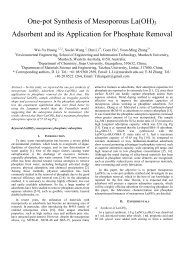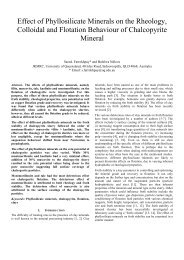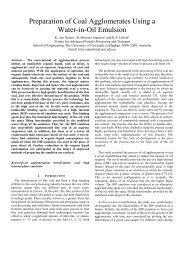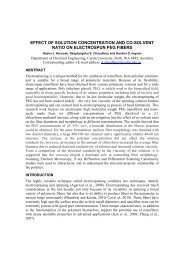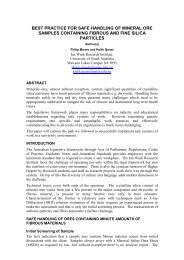a study on the calcination and sulfation behavior of limestone during ...
a study on the calcination and sulfation behavior of limestone during ...
a study on the calcination and sulfation behavior of limestone during ...
You also want an ePaper? Increase the reach of your titles
YUMPU automatically turns print PDFs into web optimized ePapers that Google loves.
A STUDY ON THE CALCINATION AND SULFATION BEHAVIOR<br />
OF LIMESTONE DURING OXY-FUEL COMBUSTION<br />
Juan Chen a,b , H<strong>on</strong>g Yao b , Lian Zhang a*<br />
a : Department <strong>of</strong> Chemical Engineering, M<strong>on</strong>ash University, Clayt<strong>on</strong>, GPO Box 36, Vic<br />
3800, Australia<br />
b : State Key Laboratory <strong>of</strong> Coal Combusti<strong>on</strong>, Huazh<strong>on</strong>g University <strong>of</strong> Science<br />
Technology, Wuhan, 430074, China<br />
*: Corresp<strong>on</strong>ding author.<br />
Tel.: +61-3-9905-2592; fax: +61-3-9905-5686. E-mail: lian.zhang@m<strong>on</strong>ash.edu<br />
ABSTRACT<br />
The mechanisms governing <strong>the</strong> behaviour <strong>of</strong> limest<strong>on</strong>e for in-furnace desulfurisati<strong>on</strong><br />
<strong>during</strong> oxy-fuel combusti<strong>on</strong> have been investigated in this paper. Apart from <strong>the</strong> use <strong>of</strong><br />
pure limest<strong>on</strong>e, <strong>the</strong> mixtures <strong>of</strong> limest<strong>on</strong>e with a brown coal (i.e. lignite) at different<br />
mass ratios were also examined to address <strong>the</strong> influence <strong>of</strong> <strong>the</strong> coal-bound ash-forming<br />
metals in <strong>the</strong> behaviour <strong>of</strong> limest<strong>on</strong>e. The combusti<strong>on</strong> c<strong>on</strong>diti<strong>on</strong>s tested were 1273 K<br />
furnace temperature <strong>and</strong> different particle residence times. With respect to gas<br />
compositi<strong>on</strong>, apart from pure air <strong>and</strong> a 27% O2/CO2 mixture, a SO2 c<strong>on</strong>tent <strong>of</strong> 1000<br />
ppmV was also doped into <strong>the</strong> two gases to examine its competiti<strong>on</strong> with <strong>the</strong> ashforming<br />
metals <strong>on</strong> <strong>the</strong> interacti<strong>on</strong> with limest<strong>on</strong>e.<br />
The inhibitory influence <strong>of</strong> <strong>the</strong> high CO2 partial pressure <strong>on</strong> <strong>the</strong> calcinati<strong>on</strong> <strong>of</strong> limest<strong>on</strong>e<br />
has been c<strong>on</strong>firmed. However, up<strong>on</strong> mixing limest<strong>on</strong>e with coal, an increase in <strong>the</strong><br />
particle temperature through radiative heat transfer from coal flame has been c<strong>on</strong>firmed<br />
to promote <strong>the</strong> calcinati<strong>on</strong> degree <strong>of</strong> CaCO3. The ash-forming metals in coal were also<br />
proven promoting <strong>the</strong> calcinati<strong>on</strong> <strong>of</strong> limest<strong>on</strong>e. It is very likely that, <strong>the</strong> Ca-Al/Si<br />
formed <strong>on</strong> limest<strong>on</strong>e surface could be partially shed away, which in turn ensured <strong>the</strong><br />
exposure <strong>of</strong> fresh surface <strong>of</strong> limest<strong>on</strong>e to undergo decompositi<strong>on</strong> <strong>and</strong> sulfati<strong>on</strong>.<br />
However, <strong>on</strong>ce <strong>the</strong> Ca-Al/Si compounds formed were molten <strong>and</strong> a eutectic film was<br />
formed <strong>on</strong> <strong>the</strong> limest<strong>on</strong>e particle surface, <strong>the</strong> gas diffusi<strong>on</strong> resistance was increased, <strong>and</strong><br />
hence, both <strong>the</strong> calcinati<strong>on</strong> <strong>and</strong> sulfati<strong>on</strong> extents <strong>of</strong> limest<strong>on</strong>e were reduced. The doping<br />
<strong>of</strong> extra SO2 through <strong>the</strong> recirculati<strong>on</strong> <strong>of</strong> flue gas mainly increased <strong>the</strong> sulfati<strong>on</strong> <strong>of</strong><br />
limest<strong>on</strong>e <strong>and</strong> c<strong>on</strong>currently reduced <strong>the</strong> un-reacted limest<strong>on</strong>e fracti<strong>on</strong> through direct<br />
sulfati<strong>on</strong>. The interacti<strong>on</strong> between limest<strong>on</strong>e/lime <strong>and</strong> ash were affected little, which<br />
still remained competitive <strong>and</strong> highly preferred for <strong>the</strong> Ca/S molar ratio <strong>of</strong> 2-4<br />
particularly under <strong>the</strong> oxy-fuel combusti<strong>on</strong> c<strong>on</strong>diti<strong>on</strong>. To achieve an efficient in-furnace<br />
desulfurisati<strong>on</strong> through limest<strong>on</strong>e injecti<strong>on</strong> for oxy-fuel combusti<strong>on</strong> c<strong>on</strong>diti<strong>on</strong>, a<br />
sufficiently high Ca/S molar ratio <strong>and</strong> <strong>the</strong> low-ash coal should be c<strong>on</strong>sidered to avoid<br />
<strong>the</strong> ash influence.<br />
Keywords:<br />
Limest<strong>on</strong>e, Calcinati<strong>on</strong>, Sulfati<strong>on</strong>, Ash, Oxy-fuel combusti<strong>on</strong>.<br />
1.INTRODUCTION
Juan chen et al.<br />
Oxy-fuel combusti<strong>on</strong> is a promising technology for coal-fired power plants to mitigate<br />
its greenhouse gas emissi<strong>on</strong> in <strong>the</strong> short/medium term. In this technology, <strong>the</strong> flue gas is<br />
recirculated to mix with <strong>the</strong> air-derived pure oxygen for combusti<strong>on</strong>. The resulting CO2<br />
c<strong>on</strong>centrati<strong>on</strong> in flue gas can reach up to 95%. Since a large porti<strong>on</strong> <strong>of</strong> flue gas is<br />
recycled, <strong>the</strong> gaseous impurities such as SO2/SO3 within it can gradually accumulate in<br />
a furnace, which in turn potentially causes extra fouling <strong>and</strong> tube corrosi<strong>on</strong> problems<br />
through <strong>the</strong> depositi<strong>on</strong> <strong>of</strong> sulfates, as well as affects <strong>the</strong> purity <strong>of</strong> <strong>the</strong> CO2 which is<br />
eventually sequestrated. To solve <strong>the</strong>se problems, an efficient capture <strong>of</strong> SO2 for flue<br />
gas clean-up is pivotal for an oxy-fuel system.<br />
In-furnace capture <strong>of</strong> SO2 through <strong>the</strong> use <strong>of</strong> limest<strong>on</strong>e is a promisingly cost-effective<br />
manner for flue-gas clean-up. As has been c<strong>on</strong>firmed for <strong>the</strong> c<strong>on</strong>venti<strong>on</strong>al air<br />
combusti<strong>on</strong>, <strong>the</strong> sulfur removal <strong>of</strong> limest<strong>on</strong>e involves two c<strong>on</strong>secutive steps: calcinati<strong>on</strong><br />
<strong>of</strong> limest<strong>on</strong>e <strong>and</strong> sulfati<strong>on</strong> <strong>of</strong> calcium oxide, (Borgwardt 1970) according to<br />
Calcinatio n : CaCO3<br />
→ CaO + CO2<br />
(1)<br />
Sulfati<strong>on</strong> : CaO + SO2<br />
+ O2<br />
→ CaSO4<br />
(2)<br />
Direct Sulfati<strong>on</strong> : CaCO + SO + 0.<br />
5O<br />
→ CaSO + CO<br />
(3)<br />
3<br />
2<br />
The calcinati<strong>on</strong> <strong>of</strong> CaCO3 by reacti<strong>on</strong> (1) is affected by two factors, CO2 partial<br />
pressure <strong>and</strong> particle temperature. The high CO2 partial pressure in an oxy-fuel furnace<br />
is expected to play a negative role. However, it is unclear if <strong>the</strong> increase in particle<br />
temperature through radiative heat transfer from coal flame will <strong>of</strong>fset this negative role.<br />
Regarding <strong>the</strong> sulfati<strong>on</strong> reacti<strong>on</strong>, apart from reacti<strong>on</strong> (2), <strong>the</strong> direct sulfati<strong>on</strong> <strong>of</strong><br />
limest<strong>on</strong>e according to reacti<strong>on</strong> (3) is also c<strong>on</strong>siderable for sulfur capture, in particular<br />
<strong>during</strong> oxy-fuel combusti<strong>on</strong>. A generalised underst<strong>and</strong>ing has yet to be achieved in <strong>the</strong><br />
literature. Liu <strong>and</strong> his co-workers (2000) c<strong>on</strong>sidered that, as <strong>the</strong> sintering extent <strong>of</strong><br />
limest<strong>on</strong>e in CO2 is decreased substantially, <strong>the</strong> direct sulfati<strong>on</strong> <strong>of</strong> limest<strong>on</strong>e exhibits a<br />
comparable rate to that <strong>of</strong> <strong>the</strong> sulfati<strong>on</strong> reacti<strong>on</strong> <strong>of</strong> calcium oxide in O2/CO2. Fuertes et<br />
al (1994) <strong>and</strong> Snow et al (1988) suggested <strong>the</strong> kinetic c<strong>on</strong>trol <strong>and</strong> fast diffusi<strong>on</strong> <strong>of</strong> gases<br />
for reacti<strong>on</strong> (3). Our previous result also c<strong>on</strong>firmed <strong>the</strong> large potential for reacti<strong>on</strong> (3)<br />
in O2/CO2 under certain c<strong>on</strong>diti<strong>on</strong>s (Chen et al., 2011). In c<strong>on</strong>trast, Iisa <strong>and</strong> Hupa (1990)<br />
hypo<strong>the</strong>sized <strong>the</strong> diffusi<strong>on</strong> limit for <strong>the</strong> directi<strong>on</strong> sulfati<strong>on</strong> <strong>of</strong> limest<strong>on</strong>e, <strong>and</strong> some o<strong>the</strong>r<br />
researchers also proposed <strong>the</strong> comparable significance <strong>of</strong> reacti<strong>on</strong> c<strong>on</strong>trol <strong>and</strong><br />
diffusivity limit (Hajaligol et al. 1988; Iisa <strong>and</strong> Hupa, 1992). Moreover, <strong>the</strong> influence <strong>of</strong><br />
<strong>the</strong> coal-bound inorganic metals <strong>on</strong> <strong>the</strong> <strong>behavior</strong> <strong>of</strong> limest<strong>on</strong>e in O2/CO2 mixture has not<br />
yet been studied. At <strong>the</strong> typical pulverized coal-fired temperatures, <strong>the</strong> interacti<strong>on</strong><br />
between calcium <strong>and</strong> alumina/silic<strong>on</strong> for <strong>the</strong> formati<strong>on</strong> <strong>of</strong> molten eutectics is a<br />
significant cause inhibiting <strong>the</strong> sulfati<strong>on</strong> capture efficiency in air (Zhang et al. 2002).<br />
The present <str<strong>on</strong>g>study</str<strong>on</strong>g> aims to address <strong>the</strong>se knowledge gaps to clarify <strong>the</strong> transformati<strong>on</strong><br />
<strong>behavior</strong> <strong>of</strong> CaCO3 in oxy-fuel combusti<strong>on</strong>. In particular, <strong>the</strong> interacti<strong>on</strong> <strong>of</strong> coal-bound<br />
metals with limest<strong>on</strong>e has been elucidated in detail, through <strong>the</strong> combusti<strong>on</strong> <strong>of</strong><br />
limest<strong>on</strong>e mixed with a low-rank lignite at different mass ratios. The lignite used is<br />
Victorian brown coal rich in organically bound metals. Its combusti<strong>on</strong> at high<br />
temperature is expected to deliver plenty <strong>of</strong> fine <strong>and</strong> even ultra-fine ash particles which<br />
2<br />
4<br />
2<br />
2
Juan chen et al.<br />
can attack limest<strong>on</strong>e through r<strong>and</strong>om collisi<strong>on</strong>. The doping <strong>of</strong> 1000 ppmV SO2 to flue<br />
gas was also c<strong>on</strong>ducted to simulate <strong>the</strong> gradual accumulati<strong>on</strong> <strong>of</strong> this impurity gas in an<br />
oxy-firing furnace. Ma<strong>the</strong>matical modelling through a shrinking core model was also<br />
c<strong>on</strong>ducted to clarify <strong>the</strong> resistance <strong>of</strong> ash layer against <strong>the</strong> diffusi<strong>on</strong> <strong>of</strong> gases <strong>during</strong> <strong>the</strong><br />
calcinati<strong>on</strong> <strong>and</strong> sulfati<strong>on</strong> <strong>of</strong> limest<strong>on</strong>e.<br />
2. THEORY SECTION<br />
The ma<strong>the</strong>matical model was used based <strong>on</strong> a reversible reacti<strong>on</strong> <strong>of</strong> equati<strong>on</strong> (1) for <strong>the</strong><br />
solid-gas decompositi<strong>on</strong> <strong>of</strong> limest<strong>on</strong>e which preferentially occurs at <strong>the</strong> solid CaCO3<br />
surface, <strong>and</strong> has an equilibrium decompositi<strong>on</strong> pressure <strong>of</strong> CO2 as (Baker, 1962):<br />
Pe = 1.826 × 10 7 exp (- 19680/T) (4)<br />
The calcinati<strong>on</strong> rate <strong>of</strong> limest<strong>on</strong>e particles is c<strong>on</strong>sidered to be chemical-kinetic<br />
c<strong>on</strong>trolled (Borgwardt, 1985). The reacti<strong>on</strong> rate at both external <strong>and</strong> internal surface is<br />
expressed as:<br />
Rate = - ks . ACaCO3 (5)<br />
The effect <strong>of</strong> <strong>the</strong> gaseous CO2 partial pressure <strong>on</strong> <strong>the</strong> reacti<strong>on</strong> rate was incorporated into<br />
<strong>the</strong> rate equati<strong>on</strong> by modifying rate c<strong>on</strong>stant ks as <strong>the</strong> following expressi<strong>on</strong>s from<br />
Darroudi <strong>and</strong> Searcy (1981), Hu <strong>and</strong> Scar<strong>on</strong>i (1996).<br />
ks = ks’ for P < 10 -2 ×Pe (6)<br />
ks = ks’ . (Pe-P)/Pe for 10 -2 ×Pe < P < Pe (7)<br />
where<br />
ks’ = 6.078×10 7 exp {-205000/(RT)} (8)<br />
Which is established by Borgwardt (1985) in a calcinati<strong>on</strong> <str<strong>on</strong>g>study</str<strong>on</strong>g> <strong>on</strong> small dispersed<br />
limest<strong>on</strong>e particles. Thus, <strong>the</strong> unreacted fracti<strong>on</strong> (x) <strong>of</strong> CaCO3 can be expressed by:<br />
ln (1-x) = - ks . Sg . MCaCO3 . t (9)<br />
Where Sg (m 2 /g) is <strong>the</strong> BET-surface area <strong>of</strong> limest<strong>on</strong>e, <strong>and</strong> is estimated as 0.4 m 2 /g in<br />
this <str<strong>on</strong>g>study</str<strong>on</strong>g>; MCaCO3 (g/mol) is <strong>the</strong> molecular weight <strong>of</strong> CaCO3; t (s) is <strong>the</strong> time. When a<br />
reactor length <strong>of</strong> 1200 mm was used, <strong>the</strong> particle residence time was estimated to be<br />
approximately 1 s including 0.2 s for <strong>the</strong> pre-heating <strong>of</strong> particles from room temperature<br />
to about 873 K where <strong>the</strong> decompositi<strong>on</strong> <strong>of</strong> limest<strong>on</strong>e commences.<br />
The sulfati<strong>on</strong> <strong>of</strong> limest<strong>on</strong>e is a very complicated process <strong>during</strong> coal combusti<strong>on</strong>. A<br />
number <strong>of</strong> researchers (Borgwardt 1970; Dennis <strong>and</strong> Hayhurst 1990; Borgwardt <strong>and</strong><br />
Bruce 1986; Borgwardt et al. 1987; Bruce et al. 1989; Ghosh-Dastidar et al. 1996) have<br />
investigated <strong>the</strong> kinetic <strong>and</strong> diffusi<strong>on</strong> <strong>of</strong> <strong>the</strong> reacti<strong>on</strong> between SO2 <strong>and</strong> calcium oxide.<br />
Moreover, many investigati<strong>on</strong>s have been made <strong>on</strong> <strong>the</strong> mechanism <strong>of</strong> direct reacti<strong>on</strong> (3).<br />
The shrinking un-reacted core model (Szekely et al. 1976) is <strong>the</strong> most frequently used<br />
model for <strong>the</strong> descripti<strong>on</strong> <strong>of</strong> <strong>the</strong> kinetics <strong>of</strong> <strong>the</strong> direct sulfati<strong>on</strong> reacti<strong>on</strong>. Snow et al.<br />
(1988), Hajaligol et al. (1988), Fuertes et al. (1993), Krishnan & Sotirchos (1993), <strong>and</strong><br />
Liu et al. (2000) have obtained <strong>the</strong> reacti<strong>on</strong> rate expressi<strong>on</strong>s <strong>and</strong> <strong>the</strong> corresp<strong>on</strong>ding rate<br />
c<strong>on</strong>stants. At higher c<strong>on</strong>versi<strong>on</strong>s, <strong>the</strong> sulfati<strong>on</strong> process is c<strong>on</strong>trolled by diffusi<strong>on</strong> in <strong>the</strong><br />
product layer. There are more arguments for <strong>the</strong> type <strong>of</strong> diffusi<strong>on</strong> c<strong>on</strong>trol in <strong>the</strong> product<br />
layer. Hajaligol et al. (1988), Krishnan & Sotirchos (1993), <strong>and</strong> Liu et al. (2000)<br />
suggested gas phase diffusi<strong>on</strong> mainly based <strong>on</strong> <strong>the</strong> fact that <strong>the</strong> product layer is porous.<br />
Iisa et al. (1992), <strong>and</strong> Fuertes et al. (1994) indicated solid-state diffusi<strong>on</strong> c<strong>on</strong>trol. There<br />
3
Juan chen et al.<br />
are much more things about diffusi<strong>on</strong> in <strong>the</strong> product layer that need to be known. In<br />
additi<strong>on</strong>, <strong>the</strong> influence <strong>of</strong> ash layer against <strong>the</strong> gas diffusi<strong>on</strong> has not been c<strong>on</strong>sidered I<br />
<strong>the</strong> literature. The un-reacted limest<strong>on</strong>e was assumed to remain as a core <strong>on</strong> <strong>the</strong> surface<br />
<strong>of</strong> which <strong>the</strong> lime derived from its decompositi<strong>on</strong> remains a layer limiting <strong>the</strong> diffusi<strong>on</strong><br />
<strong>of</strong> both CO2 <strong>and</strong> SO2 out <strong>of</strong> <strong>and</strong> into <strong>the</strong> particle.<br />
The mode developed by Szekely (1976) with <strong>the</strong> c<strong>on</strong>siderati<strong>on</strong> <strong>of</strong> both kinetic <strong>and</strong><br />
diffusi<strong>on</strong> was used, according to<br />
2 / 3<br />
1/<br />
3 ⎧Z<br />
−<br />
( )<br />
[ Z + 1 − Z 1 − X ]<br />
2 / 3 ⎫<br />
= K ∗ 1 − 1 − X + K ∗ 3<br />
− ( 1 − X )<br />
(10)<br />
Where<br />
[ ] ( )( )<br />
t c<br />
d<br />
K<br />
ρr<br />
⎨<br />
⎩<br />
Z −1<br />
0<br />
c = (11)<br />
K sC0<br />
2<br />
0<br />
ρr<br />
K d = (12)<br />
6DeC 0<br />
molar volume <strong>of</strong> CaSO 4 Z =<br />
= 3.<br />
09<br />
(13)<br />
molar volume<br />
<strong>of</strong> CaO<br />
X being <strong>the</strong> fracti<strong>on</strong>al c<strong>on</strong>versi<strong>on</strong> <strong>of</strong> CaO, Ks (m/s) <strong>the</strong> chemical rate c<strong>on</strong>tant, ρ<br />
(mol/m 3 ) <strong>the</strong> molar density <strong>of</strong> limest<strong>on</strong>e particles, r0 (m) <strong>the</strong> effective particle radius, <strong>the</strong><br />
average particle size <strong>of</strong> limest<strong>on</strong>e is 21 µm in this <str<strong>on</strong>g>study</str<strong>on</strong>g>, C0 (mol/m 3 ) <strong>the</strong> molar density<br />
<strong>of</strong> SO2, De (m 2 /s) <strong>the</strong> effective diffusivity through <strong>the</strong> product layer.<br />
A coefficient σ was proposed as:<br />
K K r<br />
= =<br />
K 6D<br />
d s 0<br />
σ (14)<br />
c<br />
e<br />
When σ 10, it is<br />
diffusi<strong>on</strong> c<strong>on</strong>trolled, <strong>and</strong> when 0.1
Juan chen et al.<br />
temperature-ashing in muffle furnace at 873 K) accounts for 0.9 wt% <strong>and</strong> 2.24 wt%,<br />
respectively. The inorganic metals within <strong>the</strong> brown coal are dominated by organically<br />
bound cati<strong>on</strong>s <strong>and</strong> ultra-fine mineral grains embedded firmly within <strong>the</strong> closed voids.<br />
These species are presumably highly reactive up<strong>on</strong> <strong>the</strong> collisi<strong>on</strong> with limest<strong>on</strong>e particle.<br />
The volatile matter accounts for more than half <strong>of</strong> <strong>the</strong> dried coal, forming a thick cloud<br />
flame in <strong>the</strong> oxidizing atmosphere (Zhang et al. 2010). Calcinati<strong>on</strong> <strong>of</strong> pure limest<strong>on</strong>e<br />
<strong>and</strong> <strong>the</strong> combusti<strong>on</strong> <strong>of</strong> coal mixed with limest<strong>on</strong>e were carried out in a lab-scale DTF as<br />
shown in Fig.1. The furnace temperature was fixed at 1273 K. Pure limest<strong>on</strong>e or coallimest<strong>on</strong>e<br />
mixture at a feeding rate <strong>of</strong> 0.5 g/min was entrained by 1 L/min primary gas<br />
(cold) into <strong>the</strong> furnace. The pre-heated sec<strong>on</strong>dary gas <strong>of</strong> 9 L/min was also fed into <strong>the</strong><br />
reactor. Two major bulk gases, air <strong>and</strong> 27% O2/73% CO2, were tested, c<strong>on</strong>sidering <strong>the</strong><br />
fact that <strong>the</strong>y match each o<strong>the</strong>r in terms <strong>of</strong> flame propagati<strong>on</strong> speed <strong>and</strong> burning coal<br />
particle temperature (Zhang et al. 2010). Three mass ratios <strong>of</strong> CaCO3 to coal were tested,<br />
18%, 5% <strong>and</strong> 1%. A SO2 c<strong>on</strong>tent <strong>of</strong> 1000 ppmV doped into mixture gas, air or 27%<br />
O2/73% CO2, were also tested. Each run lasted for ~30 min. Two reactor lengths <strong>of</strong><br />
1200 mm <strong>and</strong> 600 mm were tested, c<strong>on</strong>sidering different particle residence times. Coal<br />
combusti<strong>on</strong> ash was quenched rapidly by dry ice at approximately 5000 o C/s before<br />
passing through a collecti<strong>on</strong> system including a flask installed at <strong>the</strong> bottom <strong>of</strong> <strong>the</strong><br />
reactor <strong>and</strong> a thimble filter with a cut-<strong>of</strong>f size <strong>of</strong> 0.5µm.<br />
The un-reacted CaCO3 fracti<strong>on</strong> in a solid product was quantified through <strong>the</strong> use <strong>of</strong> a<br />
<strong>the</strong>rmogravimetric analyzer (TGA). The elemental compositi<strong>on</strong>s were quantified using<br />
X-ray fluorescence (XRF, Rigaku 2100), <strong>and</strong> <strong>the</strong> crystalline structures were determined<br />
by X-ray Diffracti<strong>on</strong> Spectrometer (Rigaku RINT XRD).<br />
4. RESULTS AND DISCUSSIONS<br />
4.1 Calcinati<strong>on</strong> <strong>of</strong> limest<strong>on</strong>e<br />
The modelling results <strong>of</strong> <strong>the</strong><br />
unreacted CaCO3 fracti<strong>on</strong> under air<br />
<strong>and</strong> 27% O2/73% CO2 at different<br />
temperatures are showed in fig 2,<br />
where <strong>the</strong> experimental results appear<br />
as discrete points for comparis<strong>on</strong>.<br />
Obviously, for <strong>the</strong> pure CaCO3, its<br />
unreacted extent after a 1200 mm<br />
reactor in O2/CO2 still accounts for<br />
55.5%, in comparis<strong>on</strong> to an unreacted<br />
fracti<strong>on</strong> <strong>of</strong> 18.9% in air. This is a<br />
direct reflecti<strong>on</strong> <strong>of</strong> <strong>the</strong> high CO2<br />
partial pressure in <strong>the</strong> oxy-fuel<br />
Unreacted CaCO3, %<br />
900 1000 1100<br />
T, K<br />
1200 1300<br />
atmosphere, which inhibited <strong>the</strong> right shift <strong>of</strong> reacti<strong>on</strong> (1). Interestingly, mixing CaCO3<br />
with coal at a mass ratio as high as 18% improved <strong>the</strong> limest<strong>on</strong>e calcinati<strong>on</strong> extent in<br />
O2/CO2 to <strong>the</strong> similar level with that obtained in air. The fracti<strong>on</strong> <strong>of</strong> <strong>the</strong> unreacted<br />
CaCO3 remaining ei<strong>the</strong>r in air or in O2/CO2 case, is also c<strong>on</strong>siderably lower than that<br />
observed for <strong>the</strong> pure limest<strong>on</strong>e. As <strong>the</strong> ash c<strong>on</strong>tent in coal are extremely lower than<br />
CaCO3 additi<strong>on</strong> percentage, <strong>and</strong> that SO2 does not participant in reacti<strong>on</strong> (1), <strong>the</strong><br />
percentage <strong>of</strong> calcium reacted with sulfur was <strong>on</strong>ly about 5% shown in fig 3 (a).<br />
Therefore, <strong>the</strong> sole explanati<strong>on</strong> for <strong>the</strong>se phenomena is <strong>the</strong> formati<strong>on</strong> <strong>of</strong> coal volatile<br />
100<br />
80<br />
60<br />
40<br />
20<br />
0<br />
Unreacted CaCO3, %<br />
100<br />
80<br />
60<br />
40<br />
20<br />
0<br />
air<br />
oxy-fuel<br />
air<br />
pure CaCO3 oxy-fuel<br />
pure CaCO3 18% CaCO3<br />
pure CaCO3<br />
18% CaCO3 + Coal<br />
+ Coal<br />
900 1000 1100 1200 1300<br />
T, K<br />
pure CaCO3 18% CaCO3<br />
18% CaCO3 + Coal<br />
+ Coal<br />
Fig. 2 Model predicti<strong>on</strong>s <strong>of</strong> limest<strong>on</strong>e<br />
calcinati<strong>on</strong> for air <strong>and</strong> oxy-fuel<br />
c<strong>on</strong>diti<strong>on</strong>s at different temperatures<br />
5
Juan chen et al.<br />
flame <strong>during</strong> coal combusti<strong>on</strong>, which substantially increased <strong>the</strong> limest<strong>on</strong>e particle<br />
temperature to a level overweighing <strong>the</strong> inhibitory effect <strong>of</strong> CO2 partial pressure. As can<br />
be seen in fig. 2, adding 18% CaCO3 to coal combusted in DTF, increased <strong>the</strong> limest<strong>on</strong>e<br />
particle temperature from 1183 K to 1223 K in O2/CO2 <strong>and</strong> 1194 K in air.<br />
Unreacted CaCO3, %<br />
20<br />
15<br />
10<br />
5<br />
0<br />
Air<br />
Oxy-fuel (a)<br />
18% 5% 1%<br />
Mass percentage <strong>of</strong> CaCO3 in coal<br />
Unreacted CaCO3, %<br />
20<br />
15<br />
10<br />
5<br />
0<br />
Air+SO2<br />
Oxy-fuel+SO2 (b)<br />
18% 5% 1%<br />
Mass percentage <strong>of</strong> CaCO3 in coal<br />
Fig 3Variati<strong>on</strong> <strong>of</strong> <strong>the</strong> fracti<strong>on</strong>s <strong>of</strong> unreacted limest<strong>on</strong>e with <strong>the</strong> additi<strong>on</strong> <strong>of</strong> limest<strong>on</strong>e<br />
The mass ratio <strong>of</strong> limest<strong>on</strong>e to ash in coal <strong>and</strong> <strong>the</strong> c<strong>on</strong>centrati<strong>on</strong> <strong>of</strong> SO2 in flue gas were<br />
also c<strong>on</strong>firmed playing noticeable role <strong>on</strong> <strong>the</strong> extent <strong>of</strong> limest<strong>on</strong>e calcinati<strong>on</strong>. As<br />
dem<strong>on</strong>strated in fig. 3, in ei<strong>the</strong>r pure gas, air versus 27% O2/73% CO2 at a reactor<br />
length <strong>of</strong> 1200 mm in panel (a), with <strong>the</strong> decrease in <strong>the</strong> additi<strong>on</strong> percentage <strong>of</strong><br />
limest<strong>on</strong>e, i.e. increase in <strong>the</strong> mass ratio <strong>of</strong> coal ash/sulfur to limest<strong>on</strong>e, <strong>the</strong> fracti<strong>on</strong> <strong>of</strong><br />
unreacted CaCO3 was decreased drastically. If <strong>the</strong> reacti<strong>on</strong>s (1) <strong>and</strong> (2) shown above<br />
are <strong>the</strong> single routes for limest<strong>on</strong>e calcinati<strong>on</strong> <strong>and</strong> sulfati<strong>on</strong>, <strong>the</strong> presence <strong>of</strong> coal ash <strong>and</strong><br />
sulfur in <strong>the</strong> furnace should not affect <strong>the</strong> extent <strong>of</strong> <strong>the</strong> right shift <strong>of</strong> reacti<strong>on</strong> (1),<br />
because <strong>the</strong>y do not participant in this reacti<strong>on</strong>. The SO2 emitted from coal-bound<br />
sulphur is also insignificant, as <strong>the</strong> sulphur in coal <strong>on</strong>ly accounts for 0.9 wt%. It is thus<br />
referrable that ash (2.24% c<strong>on</strong>tent) plays <strong>the</strong> main role <strong>on</strong> <strong>the</strong> calcinati<strong>on</strong> extent <strong>of</strong><br />
limest<strong>on</strong>e. This clearly indicates <strong>the</strong> interacti<strong>on</strong> between limest<strong>on</strong>e <strong>and</strong> coal ash,<br />
according to <strong>the</strong> following reacti<strong>on</strong> (16) <strong>and</strong> (17), respectively.<br />
CaO+ Al O ⋅ SiO →CaO⋅<br />
Al O ⋅ SiO<br />
(16)<br />
2<br />
3<br />
2<br />
CaCO 3 + Al2O3<br />
⋅ SiO2<br />
→ CaO ⋅ Al2O3<br />
⋅ SiO2<br />
+ CO2<br />
(17)<br />
The Ca-Al-Si formed could be shed away from limest<strong>on</strong>e surface, which in turn ensured<br />
<strong>the</strong> exposure <strong>of</strong> fresh surface <strong>of</strong> limest<strong>on</strong>e to undergo decompositi<strong>on</strong> <strong>and</strong> react with SO2.<br />
The directi<strong>on</strong> reacti<strong>on</strong> (17) should occur slowly in O2/CO2 with high CO2 partial<br />
pressure when compared with <strong>the</strong> interacti<strong>on</strong> (16) between calcium oxide (derived from<br />
limest<strong>on</strong>e calcinati<strong>on</strong>) <strong>and</strong> coal ash which is predominant in air (Zhang et al, 2002), as<br />
indicated by <strong>the</strong> c<strong>on</strong>stantly higher unreacted CaCO3 fracti<strong>on</strong> over <strong>the</strong> mass ratio <strong>of</strong><br />
limest<strong>on</strong>e to coal in O2/CO2 than in air. Moreover, as suggested by <strong>the</strong> results for adding<br />
1000 ppmV SO2 in fig. 3(b), it is clear that <strong>the</strong> un-reacted limest<strong>on</strong>e fracti<strong>on</strong> was<br />
reduced quickly with <strong>the</strong> additi<strong>on</strong> <strong>of</strong> SO2 compared to that without SO2 additi<strong>on</strong> in<br />
panel (a). The limest<strong>on</strong>e calcinati<strong>on</strong> extent in O2/CO2 was even increased to <strong>the</strong> similar<br />
level with that obtained in air. This is a clear reflecti<strong>on</strong> <strong>of</strong> <strong>the</strong> importance <strong>of</strong> <strong>the</strong> direct<br />
sulfati<strong>on</strong> reacti<strong>on</strong> (3) at high SO2 c<strong>on</strong>centrati<strong>on</strong> in an oxy-fuel boiler.<br />
2<br />
3<br />
2<br />
6
4.2 sulfati<strong>on</strong> <strong>of</strong> limest<strong>on</strong>e<br />
Juan chen et al.<br />
Fig. 4 shows <strong>the</strong> sulfati<strong>on</strong> extent <strong>of</strong> limest<strong>on</strong>e in different cases <strong>and</strong> <strong>the</strong> corresp<strong>on</strong>ding<br />
modelling results for comparis<strong>on</strong>.<br />
Fracti<strong>on</strong> <strong>of</strong> Ca-S, %<br />
80<br />
60<br />
40<br />
20<br />
0<br />
Modeling<br />
Air<br />
Oxy-fuel<br />
18% 5% 1%<br />
Mass percentage <strong>of</strong> CaCO3 in coal<br />
18% 5% 1%<br />
Mass percentage <strong>of</strong> CaCO3 in coal<br />
(a)<br />
(b)<br />
Fig 4 Variati<strong>on</strong> <strong>of</strong> <strong>the</strong> fracti<strong>on</strong>s <strong>of</strong> Ca-S compounds with limest<strong>on</strong>e additi<strong>on</strong><br />
Fracti<strong>on</strong> <strong>of</strong> Ca-S, %<br />
80<br />
60<br />
40<br />
20<br />
0<br />
Modeling<br />
Air+SO2<br />
Oxy-fuel+SO2<br />
As can be seen, in panel (a) for <strong>the</strong> two pure gases, air versus O2/CO2, <strong>the</strong> modelling<br />
fracti<strong>on</strong>al c<strong>on</strong>versi<strong>on</strong>s are identical, which is far higher than <strong>the</strong> experimental data. It<br />
clearly indicates <strong>the</strong> influence <strong>of</strong> ash which reacted with limest<strong>on</strong>e <strong>on</strong> <strong>the</strong> surface <strong>of</strong><br />
limest<strong>on</strong>e/lime particles <strong>and</strong> increased <strong>the</strong> diffusi<strong>on</strong> resistance <strong>of</strong> SO2. The slowest Ca-S<br />
extent for <strong>the</strong> 18 wt% limest<strong>on</strong>e additi<strong>on</strong> to coal can be attributed to <strong>the</strong> insufficience <strong>of</strong><br />
SO2 emitted from coal-bound sulfur. Decreasing <strong>the</strong> mass percentage <strong>of</strong> limest<strong>on</strong>e to<br />
1% increased <strong>the</strong> molar ratio <strong>of</strong> ash/sulfur to calcium, thus resulting in <strong>the</strong> sulfati<strong>on</strong> <strong>of</strong><br />
about 35% <strong>of</strong> limest<strong>on</strong>e in air, in comparis<strong>on</strong> to a slow increase for <strong>the</strong> fracti<strong>on</strong> <strong>of</strong> Ca-S<br />
to about 15% in O2/CO2. Combined with <strong>the</strong> limest<strong>on</strong>e decompositi<strong>on</strong> in fig. 3(a), <strong>the</strong><br />
un-reacted CaCO3 also had a slow decrease in O2/CO2 from 18% to 1% mass percentage<br />
<strong>of</strong> limest<strong>on</strong>e. This evidences that <strong>the</strong><br />
surface <strong>of</strong> limest<strong>on</strong>e is blocked by ashcalcium<br />
products. The Ca-Al/Si<br />
50<br />
compounds have low melting points <strong>and</strong><br />
Air<br />
are easily molten in reducing atmosphere<br />
40<br />
because <strong>of</strong> <strong>the</strong> char-CO2 gasificati<strong>on</strong><br />
30<br />
Air+SO2<br />
reacti<strong>on</strong> in oxy-fuel c<strong>on</strong>diti<strong>on</strong> with high<br />
Oxy-fuel<br />
c<strong>on</strong>centrati<strong>on</strong> <strong>of</strong> CO2 (Rathnam et al.<br />
20<br />
2009) , forming a eutectic film <strong>on</strong> <strong>the</strong><br />
Oxy-fuel+SO2<br />
limest<strong>on</strong>e surface which increase <strong>the</strong> gas<br />
10<br />
diffusi<strong>on</strong> resistance.<br />
The influences <strong>of</strong> ash <strong>and</strong> SO2 increase <strong>on</strong><br />
<strong>the</strong> Ca-S extent were also intriguingly<br />
observed <strong>and</strong> dem<strong>on</strong>strated in <strong>the</strong> panel (b)<br />
<strong>of</strong> fig. 4. Adding 1000 ppm SO2 into flue<br />
gas greatly increased <strong>the</strong> sulfati<strong>on</strong> extent<br />
<strong>of</strong> calcium. Especially in O2/CO2 with 1%<br />
limest<strong>on</strong>e additi<strong>on</strong>, sulfati<strong>on</strong> extent got to<br />
<strong>the</strong> similar level with that in air. 1000ppm SO2 increased <strong>the</strong> sulfur c<strong>on</strong>tent to 3.76%,<br />
Fracti<strong>on</strong> <strong>of</strong> Ca-Si/Al, %<br />
0<br />
Fig 5 Variati<strong>on</strong> <strong>of</strong> <strong>the</strong> fracti<strong>on</strong>s <strong>of</strong> Ca-<br />
Si/Al compounds with 1000ppmV SO2<br />
1% limest<strong>on</strong>e additi<strong>on</strong> in 1200 mm<br />
reactor<br />
7
Juan chen et al.<br />
higher than <strong>the</strong> ash c<strong>on</strong>tent, thus <strong>the</strong> gas-solid reacti<strong>on</strong> with SO2 became <strong>the</strong> dominant<br />
reacti<strong>on</strong>, which compensated <strong>the</strong> affect <strong>of</strong> ash. As can be seen in fig. 5, <strong>the</strong> fracti<strong>on</strong>s <strong>of</strong><br />
Ca-Si/Al compounds were decreased with SO2 additi<strong>on</strong> in both air <strong>and</strong> O2/CO2<br />
c<strong>on</strong>diti<strong>on</strong>s. The lower sulfati<strong>on</strong> extent in O2/CO2 than in air was fur<strong>the</strong>r c<strong>on</strong>firmed.<br />
Shaddix <strong>and</strong> Molina (2007) reported that O2 has a lower diffusi<strong>on</strong> rate (about 20% less)<br />
in CO2 layer than in N2. This phenomen<strong>on</strong> is explained by <strong>the</strong> lower SO2 diffusivity in<br />
O2/CO2 than in air affecting <strong>the</strong> transport <strong>of</strong> SO2 to <strong>the</strong> surface <strong>of</strong> <strong>the</strong> limest<strong>on</strong>e particle.<br />
Fig. 6 depicts <strong>the</strong> changes to <strong>the</strong> fracti<strong>on</strong>s <strong>of</strong><br />
unreacted limest<strong>on</strong>e <strong>and</strong> Ca-S with <strong>the</strong><br />
additi<strong>on</strong> <strong>of</strong> 1000 ppmV SO2 to air <strong>and</strong><br />
O2/CO2 c<strong>on</strong>diti<strong>on</strong>s. For <strong>the</strong> additi<strong>on</strong> 18%<br />
limest<strong>on</strong>e to coal in O2/CO2 case, <strong>the</strong><br />
reducti<strong>on</strong> <strong>on</strong> its unreacted fracti<strong>on</strong> is nearly<br />
equal to <strong>the</strong> increase in <strong>the</strong> percentage <strong>of</strong><br />
Ca-S, thus proving <strong>the</strong> sole significance <strong>of</strong><br />
<strong>the</strong> directi<strong>on</strong> sulfati<strong>on</strong> reacti<strong>on</strong> (3) for a<br />
high Ca/S molar ratio. For ano<strong>the</strong>r two low<br />
limest<strong>on</strong>e additi<strong>on</strong> percentages, in air<br />
c<strong>on</strong>diti<strong>on</strong> <strong>the</strong> unreacted fracti<strong>on</strong> up<strong>on</strong> SO2<br />
additi<strong>on</strong> is not changed, but <strong>the</strong> Ca-S<br />
fracti<strong>on</strong> is still increased. For O2/CO2, <strong>the</strong><br />
reducti<strong>on</strong> in <strong>the</strong> CaCO3 fracti<strong>on</strong> is far lower<br />
than <strong>the</strong> increase in <strong>the</strong> fracti<strong>on</strong> <strong>of</strong> Ca-S,<br />
particularly for <strong>the</strong> case <strong>of</strong> 1% limest<strong>on</strong>e added to coal, indicative <strong>of</strong> Ca-S not <strong>on</strong>ly from<br />
direct sulfati<strong>on</strong> reacti<strong>on</strong> (3), but also binding with sulfur from o<strong>the</strong>r approaches. Apart<br />
from <strong>the</strong> increase in <strong>the</strong> S/Ca molar ratio, <strong>the</strong> interacti<strong>on</strong> <strong>of</strong> coal ash with limest<strong>on</strong>e via<br />
reacti<strong>on</strong> (16) <strong>and</strong> (17) may also be <strong>the</strong> cause for this phenomen<strong>on</strong>. The formed Ca-Al-Si<br />
could be shed away from limest<strong>on</strong>e surface, ensured <strong>the</strong> exposure <strong>of</strong> fresh surface <strong>of</strong><br />
limest<strong>on</strong>e to undergo decompositi<strong>on</strong> <strong>and</strong> react with SO2. Besides that, our previous<br />
results (Zhang et al. 2002) c<strong>on</strong>firmed that <strong>the</strong> added limest<strong>on</strong>e reacted with<br />
aluminosilicate in <strong>the</strong> ash <strong>and</strong> fixed into calcium aluminosilicate, rich in calcium, can<br />
c<strong>on</strong>tinue to react with gaseous SO2 to remove it.<br />
5. CONCLUSIONS<br />
18% 5% 1%<br />
mass percentage <strong>of</strong> CaCO3 in coal<br />
Mechanisms for calcinati<strong>on</strong> <strong>and</strong> sulfati<strong>on</strong> <strong>of</strong> limest<strong>on</strong>e added at <strong>the</strong> mass ratios <strong>of</strong> 18%,<br />
5% <strong>and</strong> 1% to a brown coal <strong>during</strong> air <strong>and</strong> O2/CO2 mixture (27/73) in a lab-scale DTF<br />
have been investigated. The major c<strong>on</strong>clusi<strong>on</strong>s are drawn as follows: (1) The high CO2<br />
partial pressure in an oxy-fuel furnace played a negative role <strong>on</strong> calcinati<strong>on</strong>s <strong>of</strong><br />
limest<strong>on</strong>e. However, increase in <strong>the</strong> local temperature <strong>of</strong> limest<strong>on</strong>e particles through <strong>the</strong><br />
radiative heat from coal flame favoured <strong>the</strong> decompositi<strong>on</strong> <strong>of</strong> limest<strong>on</strong>e to a level<br />
similar with that achieved in air in a nominal gas residence time <strong>of</strong> approximately 4 s. (2)<br />
The ash-forming metals in coal played an important role <strong>on</strong> <strong>the</strong> calcinati<strong>on</strong> <strong>and</strong> sulfati<strong>on</strong><br />
<strong>of</strong> limest<strong>on</strong>e <strong>during</strong> oxy-fuel combusti<strong>on</strong>. The direct interacti<strong>on</strong> between ash-forming<br />
metals particularly aluminium <strong>and</strong> silic<strong>on</strong> <strong>and</strong> limest<strong>on</strong>e was more favored in <strong>the</strong> CO2dominant<br />
gas atmosphere than in air, which in turn promoted <strong>the</strong> decompositi<strong>on</strong> <strong>of</strong><br />
limest<strong>on</strong>e. The Ca-Al/Si formed could be partially shed away from limest<strong>on</strong>e surface to<br />
ensure <strong>the</strong> exposure <strong>of</strong> fresh surface to c<strong>on</strong>tinue decompositi<strong>on</strong> <strong>and</strong> sulfati<strong>on</strong>. However,<br />
Reducti<strong>on</strong>/Increase in fracti<strong>on</strong>, %<br />
24<br />
18<br />
12<br />
6<br />
0<br />
-6<br />
-12<br />
-18<br />
-24<br />
reducti<strong>on</strong> in unreacted CaCO3(Air), %<br />
increase in Ca-S(Air), %<br />
reducti<strong>on</strong> in unreacted CaCO3(O2/CO2), %<br />
increase in Ca-S(O2/CO2), %<br />
Fig.6 Changes to <strong>the</strong> fracti<strong>on</strong>s <strong>of</strong> unreacted<br />
CaCO3 <strong>and</strong> CaSO4 up<strong>on</strong> SO2<br />
additi<strong>on</strong> to air <strong>and</strong> O2/CO2<br />
8
Juan chen et al.<br />
with <strong>the</strong> decrease <strong>on</strong> <strong>the</strong> limest<strong>on</strong>e to ash mass ratio, <strong>the</strong> Ca-Al/Si compounds formed<br />
are seemingly easily molten, which in turn blocked <strong>the</strong> internal pores <strong>of</strong> particles <strong>and</strong><br />
resulted in an resistant layer hindering <strong>the</strong> diffusi<strong>on</strong> <strong>of</strong> SO2 <strong>and</strong> CO2 (derived from<br />
limest<strong>on</strong>e decompositi<strong>on</strong>) into <strong>and</strong> out <strong>of</strong> limest<strong>on</strong>e particle. (3) The direct sulfati<strong>on</strong> <strong>of</strong><br />
limest<strong>on</strong>e was <strong>on</strong>ly pr<strong>on</strong>ounced when <strong>the</strong> extra SO2 was introduced into flue gas <strong>and</strong><br />
excess Ca was present in flue gas. O<strong>the</strong>rwise, <strong>the</strong> interacti<strong>on</strong> between limest<strong>on</strong>e/lime<br />
<strong>and</strong> ash will be more influential. For <strong>the</strong> highest Ca/S molar ratio <strong>of</strong> 16 tested here, <strong>the</strong><br />
direct sulfati<strong>on</strong> accounted for approximately 6-15% <strong>of</strong> <strong>the</strong> total sulphur captured, which<br />
eliminated <strong>the</strong> discrepancy between oxy-fuel <strong>and</strong> air combusti<strong>on</strong> in which <strong>the</strong><br />
limest<strong>on</strong>e-ash interacti<strong>on</strong> is less intense <strong>and</strong> <strong>the</strong> indirect sulfati<strong>on</strong> is must fast <strong>and</strong><br />
favored by <strong>the</strong> rapid decompositi<strong>on</strong> <strong>of</strong> limest<strong>on</strong>e even at a relatively low temperature.<br />
ACKNOWLEDGEMENTS<br />
This <str<strong>on</strong>g>study</str<strong>on</strong>g> is supported by <strong>the</strong> Australian Research Council (ARC) under a Future<br />
Fellowship Grant <strong>of</strong> FT0991010. The assistance from Mr Facun Jiao <strong>and</strong> Pr<strong>of</strong><br />
Yoshihiko Ninomiya (Chubu University, Japan) <strong>on</strong> <strong>the</strong> XRF <strong>and</strong> XRD analysis are also<br />
gratefully acknowledged.<br />
REFERENCES<br />
Baker E H., J. Chem. Soc. 1962, 464-470.<br />
Borgwardt R. H., Envir<strong>on</strong>. Sci. Technol. 1970, 459-463.<br />
Borgwardt R H., AIChE J. 1985, 31: 103-111.<br />
Borgwardt R. H., Bruce K. R., AIChE J. 1986, 32: 239-246.<br />
Borgwardt R. H., Bruce K. R., Blake J., I&EC Rearch 1987, 26: 1993-1998.<br />
Bruce K. R., Gullett B. K., Beach L. O., AIChE J. 1989, 35:37-41.<br />
Chen J, Yao H, Zhang P, Xiao L, Luo G, Xu M., Proc. Comb. Inst. 2011, 33: 2837-2843.<br />
Darroudi T, Searcy A W., J. Phys. Chem. 1981, 85: 3971-3974.<br />
Dennis J. S., Hayhurst A. N., Chem. Eng. Sci. 1990,45: 1175-1187.<br />
Fuertes A. B., Velasco G., Fuente E., Parra J. B., Alvarez T., Fuel Processing<br />
Technology 1993, 36: 65–71.<br />
Fuertes A B, Velasco G, Fern<strong>and</strong>ez M J, Alvarez T., Thermochim Acta 1994, 242:161-<br />
172.<br />
Fuertes A. B., Velasco G., Fuente E., Alvarez T., Fuel Processing Technology 1994, 38:<br />
181–192.<br />
Ghosh-Dastidar A., Mahuli S. K., Agnihotri R., Fan L., Ind. Eng. Chem. Res. 1996, 35:<br />
598–606.<br />
Hajaligol M R, L<strong>on</strong>gwell J P, Sar<strong>of</strong>im A F., Ind. Eng. Chem. Res. 1988, 27:2203-2210.<br />
Hu N, Scar<strong>on</strong>i A W., Fuel 1996, 75: 177-186.<br />
Iisa K, Hupa M., Proc. Comb. Inst. 1990, 23:943-948.<br />
Iisa K, Hupa M. J, Inst. Energy 1992, 65:201-205.<br />
Iisa K., Hupa M., Yrjas P., Proc. Comb. Inst.1992, 24: 1349–1356.<br />
Krishnan S. V., Sotirchos S. V., Can. J. Chem. Eng. 1993, 71: 244–255.<br />
Liu H., Katagiri S., Kaneko U., Okazaki K., Fuel 2000, 79: 945-953.<br />
9
Juan chen et al.<br />
Rathnam R. K., Elliott L. K., Wall T. F., Liu Y., Moghtaderi B., Fuel Processing<br />
Technology 2009, 90: 797–802.<br />
Shaddix C. R., Molina A., 5th US Combusti<strong>on</strong> Meeting Organized by <strong>the</strong> Western<br />
States Secti<strong>on</strong> <strong>of</strong> <strong>the</strong> Combusti<strong>on</strong> Institute, The University <strong>of</strong> California, San Diego;<br />
2007.<br />
Snow M J H, L<strong>on</strong>gwell J P, Sar<strong>of</strong>im A F., Ind. Eng. Chem. Res. 1988, 27:268-273.<br />
Szekely J., Evans J. W., Sohn H. Y., Gas-solid reacti<strong>on</strong>s. New York: Acedamic Press;<br />
1976.<br />
Zhang L, Sato A, Ninomiya Y, Fuel 2002, 81: 1499-1508.<br />
Zhang L, Binner E, Qiao Y, Li C-Z., Fuel 2010, 89: 2703-12.<br />
Zhang L, Jiao F, Binner E, Chen L, Bhattacharya S, Ninomiya Y, Proc. Comb.<br />
Inst. 2011, 33: 2795-2802.<br />
NOMENCLATURE<br />
ACaCO3 Specific BET surface area <strong>of</strong> calcium carb<strong>on</strong>ate (m 2 g -1 )<br />
Pe Equilibrium CO2 pressure for CaCO3 decompositi<strong>on</strong> (atm, 0.1 MPa)<br />
T Temperature (K)<br />
Rate Decompositi<strong>on</strong> rate (mol s -1 )<br />
ks, ks’ Decompositi<strong>on</strong> rate c<strong>on</strong>stants (mol m 2 s -1 )<br />
P CO2 partial pressure (atm, 0.1 MPa)<br />
R Molar gas c<strong>on</strong>stant, 8.314 JK -1 mol -1<br />
Sg The BET-surface area <strong>of</strong> limest<strong>on</strong>e (m 2 /g)<br />
MCaCO3 The molecular weight <strong>of</strong> CaCO3 (g/mol)<br />
t Time(s)<br />
x The fracti<strong>on</strong>al c<strong>on</strong>versi<strong>on</strong> <strong>of</strong> CaCO3 decompositi<strong>on</strong><br />
X The fracti<strong>on</strong>al c<strong>on</strong>versi<strong>on</strong> <strong>of</strong> CaO to CaSO4<br />
Ks The chemical rate c<strong>on</strong>stant (m/s)<br />
ρ The molar density <strong>of</strong> limest<strong>on</strong>e particles (mol/m 3 )<br />
r0 The effective particle radius (m)<br />
C0 The molar density <strong>of</strong> SO2 (mol/m 3 )<br />
De The effective diffusivity through <strong>the</strong> product layer (m 2 /s)<br />
Z The ratio <strong>of</strong> CaSO4 molar volume to CaO molar volume<br />
10


